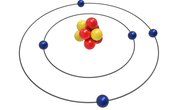Atoms, you may have heard, represent the smallest possible piece of any particular kind of matter. If you were lucky enough to have a one-pound brick of the element gold (Au), you could divide it into tinier and tinier pieces until you were left with only gold atoms; further divisions are possible, but none of the resulting components are particular to gold.
The periodic table of elements includes 118 individual types of atoms (that is, elements), all of which have a unique number of protons and electrons and a similar number of neutrons. But just how tiny is this infinitesimally small entity? Is there a way to relate the size of an atom to the radius of anything in your own experience?
What Are the Parts of an Atom?
All atoms contain at least one proton, with proton number determining the identity of an element. An element has an atomic number, the unique identifier associated with proton number and with a one- or two-letter symbol (e.g., Ca for calcium, element number 20 in the periodic table).
In the neutral, non-charged state, every atom has the same number of electrons as it does protons. Elements starting with helium also contain a number of neutrons similar to and usually slightly in excess of the proton number. Variants of elements with different numbers of neutrons are called isotopes.
Protons are negatively charges and are clustered with neutrons to form the atomic nucleus. The negatively charged electrons, meanwhile, zip about at considerable distances from the nucleus in relation to the overall size of the atom, as you'll see in detail.
What Forces Determine Atomic Size?
Atoms are characterized by their vast amount of unoccupied space, which is a seemingly bizarre observation about something already so minuscule. The atomic radius is normally defined as the distance from the center of the nucleus to the outermost electron orbital. In this sense, an atom can be represented graphically as circular, with the nucleus at the center and the outermost electron shell forming the circle's arc.
As you move from left to right along a row, proton number and electron number both increase by one with each change in element. However, because the electrons are added in a scattered way thanks to the rules of electron-orbital filling while the growing positive charge of the nucleus remains concentrated in one small space, the electrons are pulled closer to the nucleus until the noble gases in period 18 of each row.
Then, with a jump to the next row, the atoms' outermost electrons are found in an entirely new energy level, stepping up the atomic radius substantially. Then, radii decrease along the new row on the periodic table, as before.
What Is the Size of the Atomic Nucleus?
There is no formal atomic radius formula applicable to all atoms, but in covalently bonded atoms, the radius can be estimated by dividing the distance between atomic nuclei by two.
Atomic radii are generally determined by experimentation and subtraction. If the radius of one atom is known (say, calcium, about 178 picometers or pm, equal to 1.78 10–10 m), and the distance between nuclei of a calcium selenide (CaSe) molecule is 278 pm, you can subtract 178 from 278 to get a reasonable estimate of the radius of a selenium atom (100 pm).
In terms of real-world analogies, one classic size of an atom comparison relates to a sports stadium. The radius of the nucleus itself is only about 1 × 10–15 m regardless of the element, and in a typical atom, the outermost electron would be close to a football field away, or about 100 m.
Atom Size Chart
See the Resources for a graph showing the approximate values of the first 86 elements on the periodic table. These vary from about 40 pm for hydrogen to about 240 pm for cesium.
References
Resources
About the Author
Kevin Beck holds a bachelor's degree in physics with minors in math and chemistry from the University of Vermont. Formerly with ScienceBlogs.com and the editor of "Run Strong," he has written for Runner's World, Men's Fitness, Competitor, and a variety of other publications. More about Kevin and links to his professional work can be found at www.kemibe.com.
